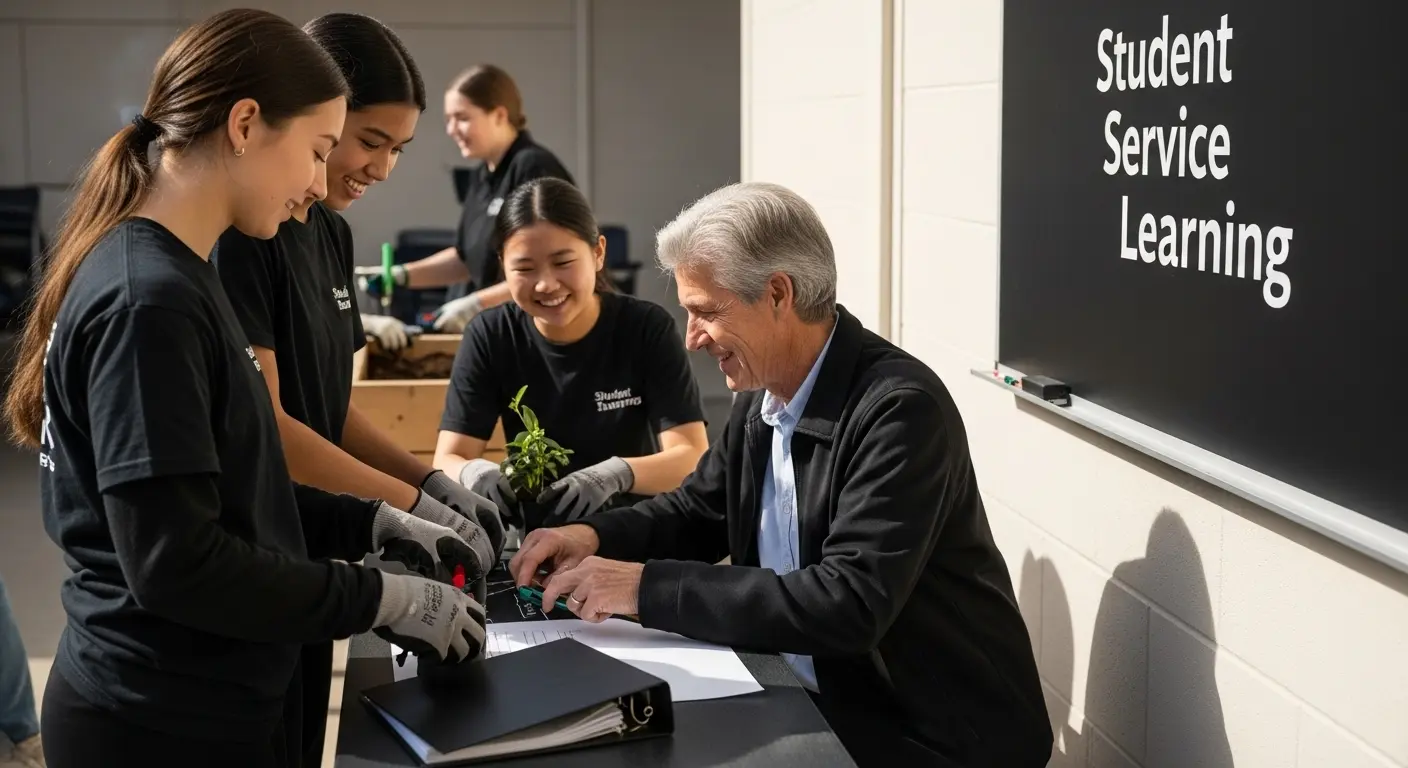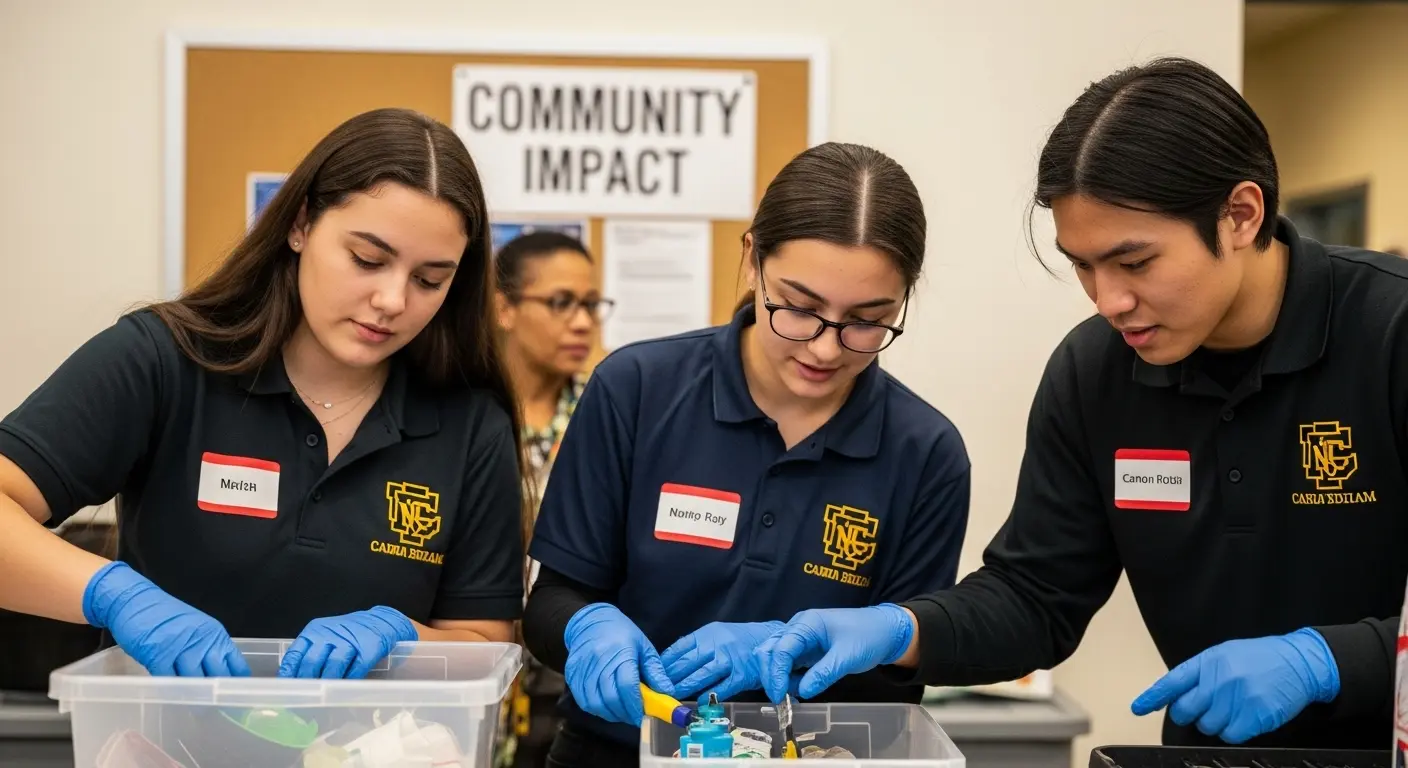Understanding Student Service Learning Projects

Student service learning projects are changing the way young people gain life experience. Every year, over 24 million students in the UK and US take part in these hands-on initiatives, turning classrooms into launchpads for real world impact. You might think these projects are just charity with a school twist, but the real power lies in how students develop skills they simply cannot pick up from textbooks.
Table of Contents
- Defining Student Service Learning Projects
- The Importance of Student Service Learning
- How Student Service Learning Projects Operate
- Key Concepts in Service Learning
Quick Summary
| Takeaway | Explanation |
|---|---|
| Student service learning integrates academics and community engagement. | It combines academic curricula with meaningful community service to enhance learning experiences. |
| Reflection is crucial for transformative learning in service projects. | Structured reflection helps students connect practical experiences with academic objectives and personal growth. |
| Service learning develops critical life skills and competencies. | Students cultivate essential skills such as teamwork, problem solving, and social responsibility through active participation. |
| Collaboration with community partners enhances project outcomes. | Working closely with community organisations ensures projects are relevant, impactful, and mutually beneficial for all involved. |
| Active citizenship and social responsibility are fostered through engagement. | Students gain a deeper understanding of social issues, becoming informed, engaged citizens ready to contribute positively to their communities. |
Defining Student Service Learning Projects
Student service learning projects represent a powerful educational approach that goes far beyond traditional classroom learning. These projects create meaningful opportunities for students to engage directly with community needs while simultaneously developing critical academic skills and personal growth.
What Are Student Service Learning Projects?
A student service learning project is a structured educational strategy that combines academic curriculum with intentional community service. According to Brown University’s Swearer Center, these projects integrate meaningful community service with instructional goals and reflective practices. The core purpose is to provide students with practical experiences that address genuine community challenges while enhancing their understanding of academic concepts.
Key characteristics of student service learning projects include:
- Direct connection between academic learning and community service
- Structured reflection opportunities
- Reciprocal benefit for both students and community partners
- Intentional alignment with educational objectives
Why Student Service Learning Matters
These projects transcend traditional volunteer work by creating a sophisticated learning environment where students develop essential life skills. Through direct engagement with community needs, students learn critical competencies such as problem solving, teamwork, communication, and social responsibility.
Students do not merely complete tasks; they become active participants in understanding complex social dynamics, systemic challenges, and potential solutions. By working alongside community organizations, they gain invaluable insights into real world contexts that textbooks cannot fully capture.
The following table summarises key characteristics that distinguish student service learning projects from traditional volunteering and simple academic study, clarifying the unique qualities outlined in the article.
| Aspect | Student Service Learning Projects | Traditional Volunteering | Classroom-Based Academic Study |
|---|---|---|---|
| Connection to Curriculum | Directly linked to academic learning | Not necessarily connected | Central focus |
| Community Engagement | Structured partnership with community | Often one-sided service provision | Rare or indirect |
| Reflection Component | Integral and structured | Infrequent or informal | Occasional, not service-centred |
| Mutual Benefit | Benefits both students and community | Primarily benefits recipients | Primarily benefits students |
| Skill Development | Focused on life skills and empathy | Skills vary, not always intentional | Academic and cognitive only |
| Assessment | Includes personal, academic, civic | Limited or informal | Standard academic assessment |
Practical Implementation
Successful student service learning projects require careful planning and collaboration between educational institutions, students, and community partners.
This involves identifying meaningful service opportunities, establishing clear learning objectives, designing structured reflection mechanisms, and ensuring sustainable community impact.
Whether addressing environmental sustainability, supporting vulnerable populations, or improving local infrastructure, these projects empower students to translate academic knowledge into tangible community contributions. The learning becomes experiential, contextual, and profoundly transformative.
The Importance of Student Service Learning
Student service learning projects represent a transformative educational approach that extends far beyond traditional academic boundaries. By integrating community engagement with academic learning, these initiatives create profound opportunities for personal, social, and intellectual growth.
Personal Development and Skill Acquisition
Service learning provides students with unparalleled opportunities to develop critical life skills that cannot be fully cultivated within classroom walls. Research from the Corporation for National and Community Service demonstrates that students engaged in service learning experience significant improvements in personal and professional competencies.
Key personal development outcomes include:
- Enhanced self awareness and emotional intelligence
- Improved problem solving and critical thinking abilities
- Development of leadership and communication skills
- Increased empathy and cultural understanding
Social and Civic Responsibility
These projects play a crucial role in nurturing active citizenship and social consciousness. Students learn to understand complex societal challenges by directly engaging with community needs. This hands on experience transforms abstract academic concepts into tangible real world understanding.
By participating in service learning, students develop a deeper comprehension of social dynamics, systemic challenges, and the importance of collaborative solutions. They move beyond passive observation to become active contributors who understand the interconnectedness of community systems.
Professional and Academic Advantages
Service learning offers significant advantages for students academic and professional trajectories. Employers increasingly value candidates who demonstrate practical experience, social awareness, and the ability to work collaboratively across diverse environments.
These projects provide students with unique opportunities to:
- Build comprehensive portfolios demonstrating practical experience
- Develop professional networks within community organizations
- Apply theoretical knowledge to real world scenarios
- Enhance personal and professional credentials
Ultimately, student service learning projects represent a holistic approach to education that prepares students not just for professional success, but for meaningful engagement as informed, compassionate global citizens.
How Student Service Learning Projects Operate
Student service learning projects function through a sophisticated, multifaceted framework that carefully integrates academic objectives with community service. These projects are meticulously designed to create meaningful learning experiences that benefit both students and community partners.
Project Design and Planning
Successful service learning projects begin with strategic planning and collaboration. Educational institutions work closely with community organizations to identify meaningful service opportunities that align with specific learning outcomes. According to the National Youth Leadership Council, this collaborative approach ensures projects are purposeful and mutually beneficial.
Key planning considerations include:
- Identifying community needs and potential impact
- Establishing clear academic and service objectives
- Creating robust mechanisms for student reflection
- Developing assessment strategies for project outcomes
Implementation and Engagement
Once designed, student service learning projects move into active implementation. Students engage directly with community partners, applying academic knowledge to real world challenges. This approach transforms theoretical learning into practical experience, allowing students to develop critical problem solving skills.
The implementation typically involves structured phases:
- Initial orientation and preparation
- Direct community service engagement
- Ongoing reflection and documentation
- Final project evaluation and presentation
Reflection and Assessment
Reflection is a cornerstone of effective service learning projects. Students are not merely completing tasks but critically analyzing their experiences, connecting them to broader academic and social contexts. Learn more about promoting lifelong learning through such immersive educational experiences.
Assessment goes beyond traditional grading, focusing on:
- Personal growth and skill development
- Understanding of community dynamics
- Contribution to community needs
- Academic learning outcomes
Through this comprehensive approach, student service learning projects create powerful educational experiences that extend far beyond conventional classroom instruction.
This table outlines the main stages of a typical student service learning project, offering clarity on the process and the core activities at each phase.
| Stage | Main Activities | Key Outcomes |
|---|---|---|
| Project Design and Planning | Identifying needs, setting objectives, building community partnerships | Aligned goals, readiness for service |
| Implementation and Engagement | Orientation, direct service, ongoing documentation | Practical experience, community contribution |
| Reflection and Assessment | Critical analysis, structured reflection, final evaluation | Personal growth, improved skills, measured impact |
 They prepare students to become engaged, empathetic, and socially responsible citizens ready to make meaningful contributions to their communities.
They prepare students to become engaged, empathetic, and socially responsible citizens ready to make meaningful contributions to their communities.
Key Concepts in Service Learning
Service learning represents a sophisticated educational approach that goes beyond traditional volunteering by integrating meaningful community engagement with academic learning. Understanding its fundamental principles is crucial for creating impactful educational experiences.
![]()
Foundational Principles
According to Vanderbilt University’s Centre for Teaching, service learning is built on three core principles: reciprocity, reflection, and community partnership. These principles ensure that service learning transcends simple volunteerism by creating mutually beneficial relationships between students and communities.
Key foundational principles include:
- Mutual benefit for both students and community partners
- Intentional connection between service activities and academic learning
- Structured opportunities for critical reflection
- Respect for community needs and perspectives
Reciprocity and Meaningful Engagement
Reciprocity is a critical concept in service learning that emphasizes balanced, two way interactions. Students are not merely providing a service but engaging in a collaborative process where both parties learn and grow. This approach challenges traditional power dynamics and promotes genuine understanding of community complexities.
The reciprocity model involves:
- Active listening to community partners
- Recognizing and valuing community expertise
- Developing solutions collaboratively
- Ensuring sustainable community impact
Reflection as a Learning Mechanism
Reflection transforms service learning from a transactional experience into a profound educational journey. Learn more about promoting lifelong learning through intentional reflective practices. Students are encouraged to critically analyze their experiences, connecting practical service with academic theories and personal growth.
Reflective practices typically include:
- Structured journaling and documentation
- Group discussions and peer sharing
- Academic assignments connecting service to coursework
- Personal and professional development assessments
By embracing these key concepts, service learning creates a dynamic educational environment that prepares students to become thoughtful, engaged, and socially responsible citizens who understand the complexity of community challenges and collaborative solutions.
Transform Student Service Learning Projects into Lasting Organisational Impact
Are you struggling to translate the powerful outcomes of student service learning projects into ongoing engagement and measurable growth for your organisation? Many educational and membership-based groups face the same challenge. While these projects encourage collaboration, skill building, and hands-on learning, managing all aspects — including member data, event coordination, and ongoing communication — can become overwhelming without the right digital tools. By integrating your service learning initiatives with a unified platform, you can streamline management, deepen engagement, and turn every project into a lasting opportunity for your community.

Take the next step towards efficiency and real growth. Discover how Colossus Systems can help you centralise member management, run impactful events, and nurture student engagement year-round. Our platform offers tailored solutions for educational and nonprofit organisations seeking to maximise the benefits of service learning. Ready to see how your next project can reach its full potential? Get in touch today and start building a stronger, more connected community.
Frequently Asked Questions
What are student service learning projects?
Student service learning projects are structured educational strategies that combine academic curriculum with community service. They provide students with practical experiences that address community needs while enhancing their understanding of academic concepts.
Why are student service learning projects important?
These projects help students develop essential life skills, such as problem-solving, teamwork, and social responsibility. They also allow students to understand complex social dynamics and contribute to meaningful community solutions.
How do student service learning projects operate?
They operate through a careful integration of academic objectives and community service, involving project design, implementation, and a strong focus on reflection and assessment to ensure both student learning and community impact.
What are the key principles of service learning?
The key principles include reciprocity, reflection, and community partnership, which ensure mutual benefit and foster meaningful engagement between students and community partners.
Recommended
- 7 Essential Leadership Skills for Students to Develop|CS
- Understanding Promoting Lifelong Learning for Everyone|CS
- Online Learning Engagement: Practical Strategies for Organisations|CS
- Understanding Leadership Development Programs in Detail|CS
- What is Hands-On Learning? Understanding Its Impact - Scheer Genius Assembly Shows
- Understanding Interactive Learning Experiences for Educators - Academic Entertainment